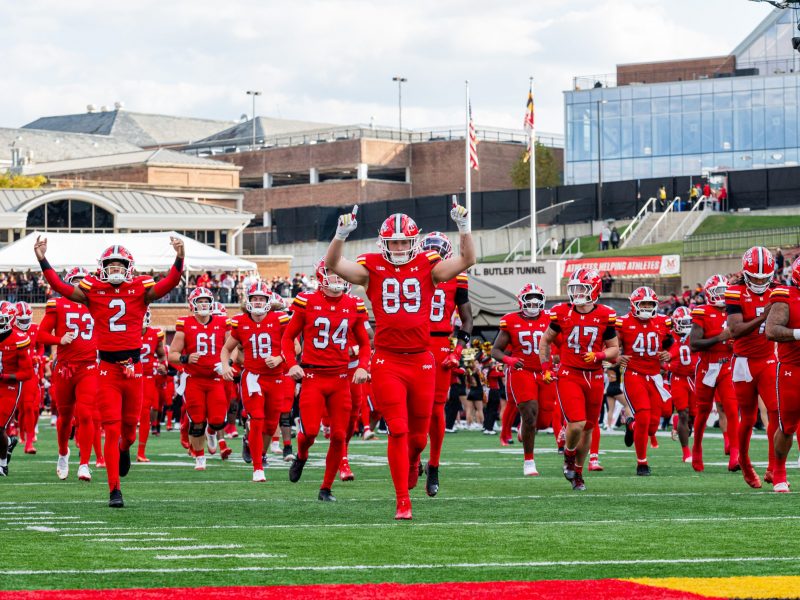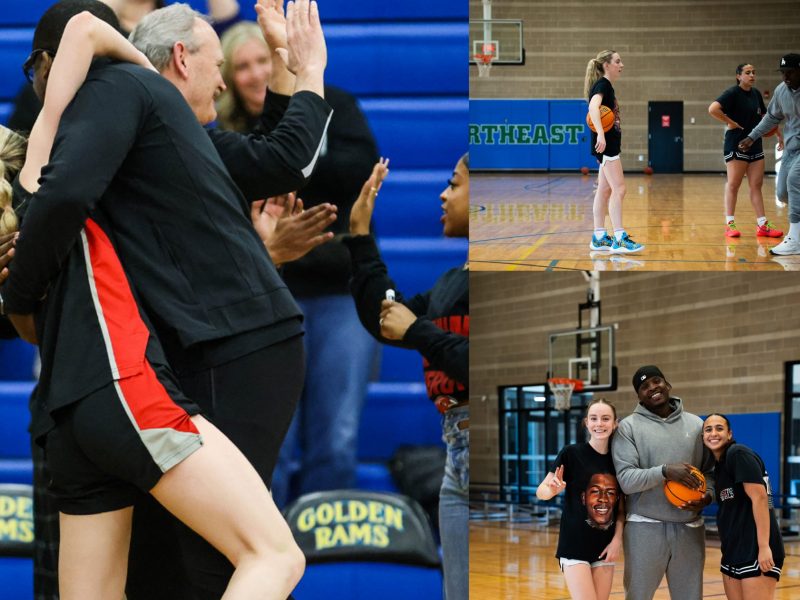
Jayson Blair: 10 Years Later
Editor’s note: This is part two of a three-part feature on Jayson Blair’s rise and fall. Look at Monday’s part and Friday’s part for the lessons learned at this university a decade later.
Tom Madigan and his Gazette coworkers were frustrated. The community newspaper had been furiously covering the 2002 Washington-area sniper attacks, and some New York Times reporter was scooping everyone with incriminating details.
The young journalist was the first to report that the United States attorney for this state ended state and federal investigators’ interrogation of John Muhammad, one of two suspects, when he seemed ready to confess.
“It did not look like the juvenile was going to talk,” the reporter quoted an unnamed local law enforcement official in an Oct. 30, 2002, article. “But it looked like Muhammad was ready to share everything, and these guys were going to get a confession.”
Within a few days, federal and state officials would denounce the story. That allegation, along with many others in Times reports surrounding the serial shootings, simply wasn’t true.
But until then, Madigan and his colleagues wondered, who the hell was this reporter from New York pumping information from Washington sources when local news outlets couldn’t?
Madigan caught a front-page Times story on the attacks and saw the byline: Jayson Blair.
He couldn’t help but chuckle to himself. Blair was a former colleague at The Diamondback, this university’s independent daily student newspaper. Blair had worked as both a writer and the editor in chief for The Diamondback, and his peers had experienced his deception firsthand.
“As soon as I saw the byline, I told people not to worry too much,” Madigan said. “I was skeptical of the quality of the journalist producing it.”
The sniper was just one of many stories that eventually led Blair, who declined several requests for comment, to resign from the Times on May 1, 2003 — exactly 10 years ago today. A Times internal investigation found he plagiarized and fabricated dozens of articles — including his coverage of the sniper attacks — and often lied about his whereabouts.
His actions would call into question the management, accuracy and accountability of the nation’s most respected newspaper.
Madigan, along with many former Diamondback colleagues and journalism college faculty, had no idea Blair’s questionable reporting would end in a cautionary tale of someone given too much too soon.
“It was amazing,” said Danielle Newman, who worked with Blair at The Diamondback. “It shocked me that it blew up to be what it was.”
‘SICK LITTLE SUSPICION’
Chris Hanson was a finalist for a tenure-track position as an associate professor in the journalism college in 1999. He sat down for a one-on-one interview with then-Dean Reese Cleghorn, and later spoke with Blair, a student involved in the selection process who had been offered a job at the Times.
The quick-minded senior quizzed Hanson’s knowledge of several plagiarism cases, including that of Mike Barnicle, a former Boston Globe columnist who fabricated and plagiarized many columns. Blair later told Hanson he was the stronger candidate because of how well he knew and understood the cases.
“He was praising me for knowing the issue well,” Hanson said. “Rather ironic.”
Hanson had an unsettling feeling when he saw Blair’s front-page story on Dec. 22, 2002, which flatly stated all evidence pointed to 17-year-old Lee Malvo as the main — and perhaps only — gunman in the sniper attacks. It was an unexpected development, given that Muhammad, 41, was a trained Army infantryman. Blair cited five pieces of evidence and quoted anonymous law enforcement officials.
Hanson wondered how an inexperienced reporter who didn’t live in Washington could possibly have sources feeding him such incriminating information.
Days later, Hanson’s question was answered when a Virginia commonwealth’s attorney called a news conference to rebuke Blair’s reports.
“I don’t think that anybody in the investigation is responsible for the leak,” Robert Horan Jr. said, “because so much of it was dead wrong.”
The news conference was only the beginning. Over the next five months, the questions surrounding Blair’s work grew. When The San Antonio Express-News raised concerns over striking similarities between one of Blair’s articles and one the paper ran on April 18, 2003, Times editors began a full investigation of Blair’s work.
His editors found he’d lied about his travels, as he claimed to be in various cities on reporting assignments and submitted expense reports when he never left New York. He concocted scenes based entirely on secretly obtained, unpublished photographs from a private Times database. And he made up entire quotes and anonymous sources while covering high-profile national stories.
His career at the Times was effectively over. By May 1, he announced he was leaving the newspaper after a nearly four-year run.
Ten days after Blair’s resignation, the Times ran a 7,239-word front-page story detailing the 27-year-old’s journalistic misdeeds. Five Times reporters, who talked to more than 150 people, including editors and Blair’s sources, wrote that the incident served as a “low point in the 152-year history of the newspaper.”
And it wasn’t just Blair who faced intense scrutiny. His consistent, calculated lying prompted many Times reporters to come forward with mounting complaints about the newspaper’s management. The Times’ top-ranking editors, Gerald Boyd and Howell Raines, resigned five weeks after Blair.
The once-celebrated journalism college student, who never finished his degree, was making national headlines for one of the most notorious scandals in the field’s history. Blair, who had quizzed Hanson on past plagiarism cases a little more than a half-decade earlier, had carved his own place in journalism lore. He’d given the paper what Times publisher Arthur Sulzberger Jr. later called a “huge black eye.”
“My sick little suspicion in the pit of my stomach was true,” Hanson said.
IN RETROSPECT
There was his picture smacked on the cover of Newsweek. Blair sported short black hair, a beard and glasses while smoking a cigarette. “The secret life of Jayson Blair” filled the magazine cover in capital block letters on a May 2003 issue.
He was suddenly the first student from the Philip Merrill College of Journalism to appear on the cover of the former weekly news magazine, which boasted a circulation of about 3 million at the time.
“There were people here who were very angry at him,” said Carl Stepp, a journalism college professor who often spoke with Blair. “He embarrassed himself and he embarrassed us, but it was mostly sadness. It was a wasted career of a very talented young man.”
Faculty members wondered if they’d ignored warning signs while Blair was a student in the late 1990s. Could they have stopped him, they thought, or at least helped before it was too late?
“You always have that question,” Stepp said. “As a teacher, I think every day there is some troubled student here that I need to see.”
Former Diamondback staffers said the Times saga was only proof of what they knew six years earlier.
Thirty alumni, including Newman and Madigan, signed a letter, addressed to three figures they felt were key in Blair’s rise, in June 2003: Thomas Kunkel, then the journalism college dean; Christopher Callahan, then an associate dean; and Ivan Penn, who helped elect Blair as editor in chief of The Diamondback.
The former students wanted answers about Blair’s time at the university, they wrote. They wanted the journalism college and The Diamondback to conduct their own reviews of Blair’s work and “create a more open and even-handed environment of communication for current students.”
In the letter, the former students reminded Kunkel, Callahan and Penn of when they first expressed their problems with Blair. He had no editing or management experience before helming The Diamondback, they said, and they could not verify some of the facts he gathered while he was a reporter.
And as the paper’s leader, they wrote, he was unreliable with his work responsibilities. He disappeared “for long stretches” and didn’t properly pay his staff members. Even though Blair is black, the alumni wrote, “race had nothing to do with it.”
But there was one thing staff members desired above all else.
“Finally, and most importantly, we ask that you listen,” the alumni wrote. “Listen when current and future Diamondback staffs raise concerns, particularly the senior members.”
The staff members had a point, Stepp thought. Perhaps Blair’s rise to stardom should have been slowed down while he was a student.
“You want to respect students and encourage students, but you also want to be careful and remember they’re still young and still insecure and need a lot of help,” Stepp said. “How do you push them and treat them like adults, but know they’re going through a lot of stuff you don’t know about?”
SCHADENFREUDE
Newman often grew enraged with Blair when they both worked at The Diamondback in the late 1990s. When they passed each other in the journalism college’s hallways, Newman always mumbled insults under her breath.
One day, she was so vexed that she sent an email to Blair.
“You’re gonna get busted one day, just like Janet Cook [sic],” she wrote to the then-editor in chief, referencing a Washington Post writer who won a Pulitzer Prize in 1981 for a story that was later found to be fabricated.
“You don’t even know how to spell her name,” Blair responded, referencing the missing “e” in Cooke’s last name.
So when Blair’s journalism career met an unceremonious end, former Diamondback staffers said only one word perfectly summed up how they felt: schadenfreude, which means taking glee in someone else’s misery.
Faculty felt differently.
“It was sad to see a former student sort of at the vertex of a huge journalistic problem,” said Chris Harvey, the journalism college’s internship and career development director who taught Blair in an intensive reporting class. “You don’t want to ever see somebody do poorly, and especially students who showed so much promise.”
When Newman read through the extensive Times story detailing the errors in Blair’s work, she said she and former Diamondback staffers related to the Times’ metropolitan editor, who in 2002 wrote an email to administrators about Blair.
“We have to stop Jayson from writing for the Times,” Jonathan Landman wrote, according to the 2003 Times article. “Right now.”
Newman hadn’t seen many of her college newspaper friends in years, she said, but Blair’s downfall called for a party.
The Friday following Blair’s resignation, she got the day off from her Washington Post job and invited the former staff members to her house. The festivities came about six years after the group met in the middle of the night at Plato’s Diner to decide what to do about their irresponsible boss.
Newman mounted Blair’s Times mugshot on a dartboard she borrowed from her parents, and the old Diamondback staffers took turns pelting darts. And, of course, they played “Lyin’ Eyes,” the Eagles song that had become a sort of anthem during their trying experience with Blair. They were once again singing the lyrics together: “You can’t hide your lyin’ eyes.”
The 20-somethings couldn’t help but enjoy knowing Blair’s deceitful ways had finally caught up with him. But Madigan, who said he can still hear Blair’s characteristic cackle, struggled to believe his former peer so publicly imploded.
“You’re going to work with a lot of people in your career,” he said. “I don’t see a lot of use crying and moaning about it happening because it does happen. I do hope the next time it does, people pay attention to the warning signs.”
newsumdbk@gmail.com



